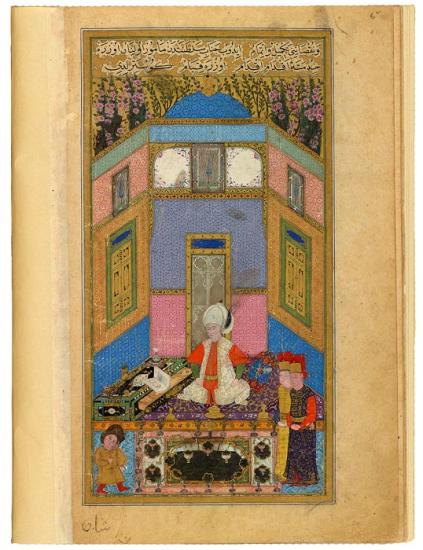
Sultan MurĀd III in his Library
Maṭāli˓ al-sa˓āda wa manābi˓ al-siyāda (The Ascension of Propitious Stars and Sources of Sovereign), in Turkish
Illuminated by Vali Jan for ˓Āyisha Sulṭān (d.1604), the daughter of Sultan Murād III
Purchased in 1935
Murād III (r. 1574–95), the son of Selim II (r, 1566–74) and grandson of Süleyman the Magnificent (r. 1520–66), ushered in a golden age of Ottoman painting, commissioning illustrated manuscripts of historical, literary, and scientific texts, many made in Istanbul's imperial scriptorium. He also ordered that texts be translated into Turkish.
Here Murād III actually admires the very manuscript for which this is the opening miniature—-the Maṭāli˓ al-sa˓āda, made for his daughter ˓Āyisha Sulṭān.; He is examining the section of the manuscript depicting zodiacal signs and the three planets associated with their decades. The face of the sultan, alas, has been altered, perhaps by a later owner, as he should have been depicted with a beard, as he is in the closely related miniature in Paris. The book is supported by the open drawer of a luxurious portable desk of ebony and ivory, on top of which are various implements, including an hourglass and a western clock. Murād is attended by two janisarries wearing their elite and distinctive headgear, and a dwarf.
Murād was interested in astronomy, cosmology, demonology, poetry, and mysticism and ordered a Turkish translation (1590) of Aflākī's life of Rūmī, Persia's greatest poet and mystic. Murād wrote poetry, and in 1584 built the kitchen and dervish cells of the Mevlevī convent in Konya, where he had gone with Selim during the siege of 1559 (see MS M.466, fol. 131r). As sultan, Murād never left Istanbul but took full advantage of the imperial harem. By the time of his death at age forty-nine he had fathered one hundred and two children and left seven pregnant concubines; sixty-two died during his lifetime, and nineteen sons were murdered by Mehmed III when he ascended the throne.
Natural History and Astrology
The miniatures presented here derive primarily from two extraordinary Islamic manuscripts that depict the natural world and the heavens. The first, Manāfi˓-i hayavān (The Benefits of Animals), is considered one of the ten greatest surviving Persian manuscripts. It dates from the reign of Ghazan Khan (1295–1304), the Mongol ruler who ordered a Persian translation of the book, and concerns the nature and medicinal properties of humans, animals, birds, reptiles, fish, and insects. The other, Matāli˓ al-sa˓āda wa manābi˓ al-siyāda (The Ascension of Propitious Stars and Sources of Sovereign), was commissioned by Sultan Murād III (r. 1574–95), an Ottoman ruler deeply interested in astronomy, cosmology, demonology, poetry, and mysticism.
